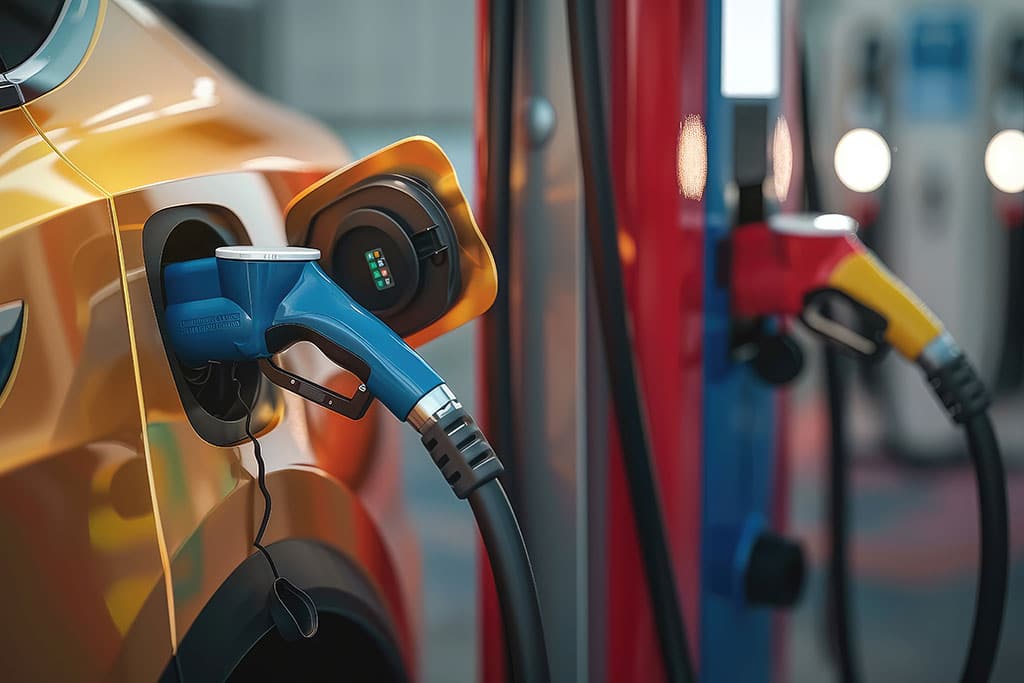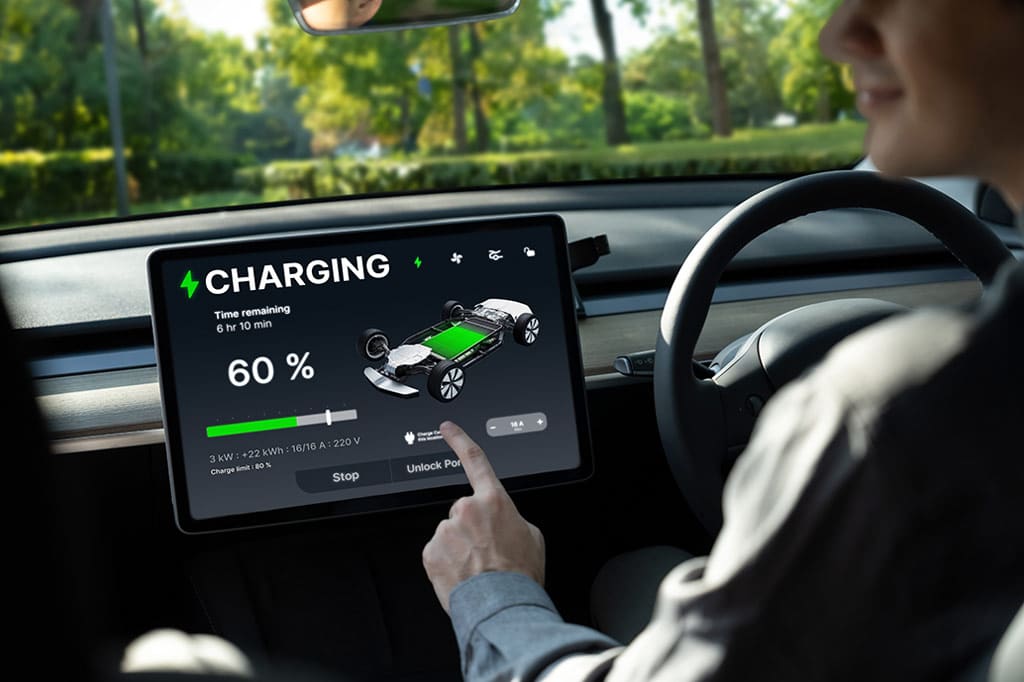Electric car transportation
Everything you need to know about shipping electric vehicles
Some might think that shipping a car is shipping a car. But that’s definitely not the case. There are specific nuances and challenges to transporting an electric vehicle (EV) from point A to point B.
From curb weight and safe handling to battery charge requirements and cost, we cover it all in this comprehensive guide to transporting an EV.
Table of contents
01
Automotive transport: a history
The history of moving vehicles from one place to another goes all the way back to the invention of the automobile itself. Manufacturers quickly realized they needed a way to get their vehicles from a factory to buyers throughout the country.

At first, automobile transport was simple. In the early days, cars were transported using horse-drawn carriages or flatbed railcars.
But as the industry grew, so did the methods of transport. The introduction of the automobile carrier, which can transport several cars at once, was a breakthrough that enabled the mass transportation of vehicles anywhere there were roads.
And then came the formation of the auto shipping industry beginning in the late 19th century. The first gas-powered automobile and the geographic expansion of car manufacturing also helped spur the industry’s growth.
Today, the auto shipping industry is a vital part of the global transportation industry, transporting millions of cars every year. However, there are several challenges and trends that are shaping its future. One of the most significant is the increasing demand for EVs and hybrid vehicles. As more people switch to EVs and hybrids, auto shipping companies need to adapt their equipment and processes to handle these vehicles.
But EVs and hybrids require different methods than a gas-powered car to effectively and safely transport them.
02
Transporting an ICE vehicle vs. an EV
In its simplest form, transporting a traditional Internal Combustion Engine (ICE) vehicle is the same as transporting an EV. But, when you get into the nuts and bolts, there are some major differences to be aware of.

EVs weigh more than ICEs
In general, an EV has a heavier curb weight than an ICE. Curb weight is the weight of the vehicle including a full tank of fuel and all standard equipment. It does not include the weight of any passengers, cargo, or optional equipment and is considered the closest measurement to the actual weight of the vehicle.
While the vehicle components of an EV and an ICE typically weigh the same, it’s the battery that pushes the EV weight up drastically. The battery of an average EV is between 660 and 1,100 pounds. Below is a chart of the approximate curb weight of several EVs on the market and their comparable-sized ICE vehicles.
| EV Model | Curb weight | Comparable ICE Model | Curb weight |
|---|---|---|---|
| Nissan LEAF | 3,509 lbs. | Nissan Sentra | 3,036 lbs. |
| Chevrolet Bolt | 3,680 lbs. | Chevrolet Cruze | 2,870 lbs. |
| Ford F-150 Lightning | 6,015 lbs. | Ford F-150 | 4,391 lbs. |
| Ford Mustang Mach-E | 4,678 lbs. | Ford Mustang | 3,542 lbs. |
| Tesla Model 3 | 3,862 lbs. | Toyota Corolla | 2,955 lbs. |
| Hyundai Ioniq 5 | 4,861 lbs. | Jeep Grand Cherokee | 4,238 lbs. |
Keep in mind that these figures are based on the standard range or base EV model. As manufacturers extend the mileage range on newer EVs with a bigger battery, and Americans continue to prefer SUVs or other large vehicles, the curb weight will only continue to grow.
But wait, the battery weight has an upside
Because the heavy EV battery sits at the floor of the vehicle, versus the weight being concentrated at the front of an ICE vehicle, EVs have a lower center of gravity. That means greater stability and less susceptibility to sudden forces during shipment.
This is especially true during container loading, which is usually flat or with the hood angled upwards. The container can be subject to rough handling, which creates momentum and risk for the vehicle to move around inside the box. But the EV can stay steadier than the ICE because the weight is more evenly distributed.
During transit, the vehicles can be exposed to forces that will make them sway slightly to the side. If the center of gravity is sitting at the top-front of the vehicle (in an ICE), this motion will have greater effect than if the center of gravity is sitting towards the floor of the vehicle (in an EV), which better anchors the car in place.
How weight impacts transportation costs
As you can imagine, the increased weight per vehicle means fewer vehicles per hauler. Since federal law says carriers can’t haul more than 80,000 pounds of Gross Vehicle Weight (GVW), hauling multiple EVs can reduce the load factor by up to 20%. As a result, carriers are increasingly forced to leave slots empty to keep their total tonnage within federal weight limits.
An empty auto hauler alone can weigh 40,000 pounds, leaving the capacity to transport nine Toyota Corollas (around 1.5 tons each) or nine Tesla Model 3s (around 2 tons). Around nine vehicles are usually the maximum, regardless of whether it’s an EV or an ICE. But heavier cars present a challenge. It’s possible to mix and match heavier and lighter vehicles on one trailer, but that isn’t always possible.
Ultimately, shipping a heavier vehicle is going to cost you more because it increases the total weight of the shipment. Aside from adhering to the federal weight limitations, fuel consumption is a primary concern. More weight on the trailer leads to a significant drag, which uses up more fuel (and costs more).
Additionally, the process of loading and securing larger vehicles on a transport carrier is often more complex, may require specialized equipment and is time-consuming. This can translate into higher labor costs, which are then factored into your shipping cost.
At Reindeer, we can get creative and find a solution that fits your cost and weight requirements.
03
Battery charge requirements and how it varies by destination
Did you know that on average, an EV loses 4% of its battery life every day in transport and that there are no set rules and regulations on State of Charge (SOC) during transport?

The ideal range is between 20% and 80%, but it depends on the vehicle type and destination. Charging at or near 100% is not good for battery health, and neither is letting it get below 20%.
Recommendations and/or requirements of specific locations include:
- 80%+ charge when shipping to Alaska
- between 45% and 65% charge when you release it to the carrier in Hawaii
- 80%+ charge at pickup for international and Canadian moves
- 60-80% charge for domestic shipping
The requirements for a specific charge level “at pickup” begs the question, who’s responsible for charging the vehicle? If you ship your vehicle with Reindeer, we handle the charging for you. Through Reindeer Premier Solutions, we can move, store and charge your EVs so they’re ready when you need them.
All our 14 storage and service hubs around the country are equipped with Level 2 chargers, which offer higher-rate AC charging than a Level 1 charger (typically seen in a consumer’s home). With our EV industry experience and charging infrastructure, we make sure your vehicles are charged appropriately prior to being shipped to the final destination.
Factors that impact charge during transport
There are several factors that can degrade the charge of an EV during the transportation process.
1. Battery drain
First, a lithium-ion battery will naturally lose charge – referred to as battery drain – even when not in use because it continues to discharge a very small amount of energy. According to the European Vehicle Logistics (ECG) general guidelines on electric vehicle handling, a lithium-ion battery loses about 5% of its charge every month it sits idle. However, we typically see much higher rates than that.
EV battery drain can have several causes. In some EVs, the Battery Management System (BMS) continuously monitors and maintains battery health. This can include heating the battery when the temperature outside is very low or cooling it in extremely hot weather, which still requires power.
Modern EVs have services for updates and remote monitoring, which connect via Wi-Fi and use battery power. Cabin conditioning to maintain the cabin temperature for comfort or to protect the hardware in the car can drain the battery if set to activate while parked.
During transport, there are some things you can do to help prevent battery drain. These include:
- 1. transporting your vehicle in an enclosed carrier and/or a temperature controlled one
- 2. using features like scheduled charging or energy saving modes to minimize battery drain
- 3. disabling unnecessary features such as cabin preconditioning when the vehicle is parked for extended periods
Some vehicles even come with a transport mode setting that is designed to maximize battery life while being shipped.
2. External temperature
Batteries are sensitive to temperature extremes. Very cold or very hot weather can compromise battery health over time, reducing the capacity to hold charge effectively. The commonly accepted threshold for accelerated battery degradation is roughly 86 degrees F. While temperatures at or below 20 degrees are bad for driving performance, it doesn’t permanently harm the battery.
3. Humidity
What comes along with high temperatures? Usually humidity, especially in certain parts of the country. High humidity can cause corrosion in the battery. This corrosion can significantly reduce the lifespan of the battery, making it weak over time and unable to store as much energy.
Owning and transporting an EV shouldn’t be a scary endeavor! If you’re looking at transporting your vehicle, let Reindeer Logistics help. As an industry leader in EV logistics, we’ll make sure your vehicle is transported in a safe and efficient manner and help you eliminate the risk of any battery related issues.
04
Regulations and safety considerations
Most EVs are powered by lithium-ion batteries. Today's lithium cells and batteries are more energy dense than ever, which comes with greater risk and the need to manage it.

That’s why the U.S. Department of Transportation classifies ALL lithium cells and batteries Class 9 hazardous materials, no matter the size or quantity under the Hazardous Materials Regulations (HMR). Shipments to, from, or within the United States are subject to the HMR.
However, because the battery is fully enclosed inside the vehicle, shipping an EV is not considered hazardous. But you still need to proceed with caution and let your shipping company know that your vehicle has a lithium-ion battery.
Shippers also play an important role in reducing the risks and preventing incidents. For instance, following the recommended precautions outlined by the US DOT. Some of these include:
- Lithium battery must be securely fastened in the battery holder.
- Vehicles that can be handled in non-upright positions (e.g., scooters, hoverboards, or bikes) must be secured in a strong, rigid outer package. The vehicles must be secured in a manner to prevent changes in orientation or damage to the vehicle.
- Lithium batteries must be protected from damage and short circuit (e.g., by using non-conductive caps to cover terminals).
Some of the conditions harmful to the battery and that may compromise its safe transport include:
1. Vibration
Vibration can cause the battery cells to break apart, which can lead to a fire. Throughout operation, EV components experience various vibrations based on driving speed, road surface, cooling system, electric motor and auxiliary systems. Also, the battery pack structure can be damaged under vibration and shock environments, and electrical connection inside the battery pack can be unstable under the vehicle vibration environment.
However, when lithium batteries are used in vehicles, the battery packs or battery modules must meet certain safety and reliability standards. That is, they must be designed to work fail-safe against abuse or harsh operational conditions, according to Siemens, a supplier in EV automation and digitalization technology.
Most standardized abuse tests for EVs cover mechanical, thermal, and electrical testing. Mechanical testing includes two main categories: vibration tests and crush tests. And several independent standards for vibration testing have been developed by various governing bodies.
2. Moisture
Even a small amount of water can wreak havoc on an EV or PHEV battery system. Unlike traditional gas-powered cars, hybrids and EVs rely on complex battery systems that contain a variety of chemicals and components that are highly sensitive to water contamination.
Once exposed to water, these chemicals can react and corrode, rendering the battery ineffective and potentially hazardous, like starting a fire. A wet battery is considered totaled, so the entire battery must be replaced. So, make sure the battery pack is kept away from moisture.
The good news is, most modern EVs are designed and built to withstand various weather conditions, including rain. So, unless your EV is submerged in water due to flooding or a hurricane, your battery should be fine during transport.
3. Heat
High temperatures are probably the most detrimental to an EV battery. It not only impacts the driving range, but it can also degrade the battery. Or worse, cause a fire.
On a chemical level, extreme heat is akin to a slow-moving cancer for EV batteries. That’s because when temperatures go up, the ions in a car battery speed up. Once that happens, they can have trouble attaching to the anode or cathode. The anode and cathode are the electrodes in the battery that the electrons move between to transfer power. The pressure and speed can also create small cracks, which slow chemical reactions and make for less usable battery life.
Lithium cells and batteries can overheat and ignite under certain high-heat conditions. Once ignited, these fires can be difficult to extinguish. Although not common, thermal runaway (when the battery just keeps generating its own heat) can lead to a violent release of stored energy and flammable gas that can easily spread to other batteries or conductive materials nearby. If you have multiple EVs close together on a shipment, it can be catastrophic.
DID YOU KNOW? When shipping an EV by cargo vessel, many of our carriers require the EV to be shipped in a container. This can increase the cost of the shipment significantly.
05
Proper training & handling
Everything we’ve already discussed leads us to the final crucial part of shipping an EV – a carrier that has specialized training and the equipment necessary to safely ship these vehicles.

The people who handle your EV during shipment must be trained to safely handle and transport it. Car shipping companies must also use the proper equipment, such as pallet jacks and forklifts that are designed to support the extra weight of an EV.
Andrei Corniciuc, Owner of Effortless Transport and a Reindeer partner, said his drivers are specifically trained to haul EVs. Before transport, the driver checks the vehicle’s charge to make sure there’s enough battery to make the journey. They also check to see that all applicable parts, including charging cables, are with the vehicle upon pickup. Lastly, they ensure the vehicle is set to transport mode.
Corniciuc explains transport mode saying, “This ensures that the proximity sensors and key fob are not triggered while in transit. It also ensures that there are no malfunctions or involuntary triggers to crash awareness software or camera software while in transit.”
Shipping EVs is more secure and efficient than ever before. This is primarily due to the developments and advancements in the EV manufacturing industry, leading car shippers to develop their shipping methods in return.
For example, car shippers started to develop dedicated EV shipping vessels and containers that could haul large numbers of EVs, making shipping faster and more affordable. Specialized EV shipping containers provide extra safety features, like fire suppression systems, temperature monitoring systems, shock absorption systems, and even charging infrastructure.
Effortless Transport has also adopted special shipping measures and equipment for its car haulers. The company uses a special trailer that can handle the increased weight of EVs. And it gives them a wide range of loading opportunities. For example, the 5-unit configuration can be a mix of two Tesla Model Xs, two Models 3s and one Cyber Truck or two large Rivian EDV700 vans.
Trust your EV move to the experts at Reindeer Logistics
Whether you’re transporting one or 500 EVs, Reindeer Logistics is an industry expert, shipping more than 10,000 EVs per year and has the expertise to ship your assets in a safe and secure manner. And if you also need long or short-term storage and charging, we have 15 electrified storage hubs throughout the country to facilitate your needs.
At Reindeer, our mission remains to provide the highest quality of shipping services to corporate relocation specialists, fleets, exporters, and individuals alike. We provide the highest level of care, communication, and consistency with every vehicle we move. From pick up to delivery, we handle every detail, track the progress, and keep you in the loop throughout the entire process.
We operate an extensive network of highly reputable, licensed, bonded and insured carriers, allowing us to meet your many service needs in a timely manner, regardless of the place of origin or the final destination. We pride ourselves on our approach to real. personal. service. which demonstrates our superior reputation and sets us apart from our competitors.
If it's got wheels, we move it!
Why choose us
Over 500,000 vehicles moved in the United States, Canada & worldwide.
01
real.
When you work with Reindeer Logistics you will never encounter a maze of computer recordings or an automated telephone system. No matter when you call, you will talk with a real, live person who is trained to guide you through the auto relocation process.
02
personal.
All our customers are assigned a relocation coordinator whose main objective is to anticipate and accommodate your every need. Your coordinator will be dedicated to you from pick up to delivery, ensuring that your car is where you want it, when you want it.
03
service.
Reindeer’s commitment to constant product and service improvement is the ultimate demonstration of our promise of delivery, quality, predictability and status.
Customer testimonials
What our customers say
Privacy Overview
| Cookie | Duration | Description |
|---|---|---|
| cookielawinfo-checbox-analytics | 11 months | This cookie is set by GDPR Cookie Consent plugin. The cookie is used to store the user consent for the cookies in the category "Analytics". |
| cookielawinfo-checbox-functional | 11 months | The cookie is set by GDPR cookie consent to record the user consent for the cookies in the category "Functional". |
| cookielawinfo-checbox-others | 11 months | This cookie is set by GDPR Cookie Consent plugin. The cookie is used to store the user consent for the cookies in the category "Other. |
| cookielawinfo-checkbox-necessary | 11 months | This cookie is set by GDPR Cookie Consent plugin. The cookies is used to store the user consent for the cookies in the category "Necessary". |
| cookielawinfo-checkbox-performance | 11 months | This cookie is set by GDPR Cookie Consent plugin. The cookie is used to store the user consent for the cookies in the category "Performance". |
| viewed_cookie_policy | 11 months | The cookie is set by the GDPR Cookie Consent plugin and is used to store whether or not user has consented to the use of cookies. It does not store any personal data. |